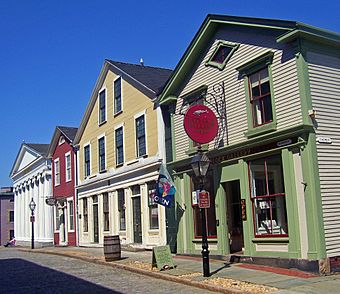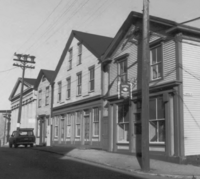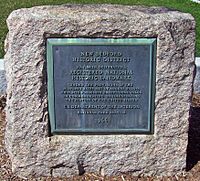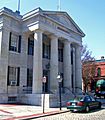New Bedford Historic District facts for kids
|
New Bedford Historic District
|
|

View along North Water Street, 2008
|
|
| Location | New Bedford, Massachusetts |
|---|---|
| Area | 19.6 acres (7.9 ha) |
| Built | 1790 |
| Architect | Russell Warren, Robert Mills, others |
| Architectural style | Greek Revival, Federal |
| NRHP reference No. | 66000773 |
Quick facts for kids Significant dates |
|
| Added to NRHP | November 13, 1966 |
| Designated NHLD | November 13, 1966 |
The New Bedford Historic District is a very special old area in New Bedford, Massachusetts, United States. It's located just west of the city's waterfront. In the 1800s, this area was the busy downtown of New Bedford. At that time, New Bedford was the most important city for the American whaling industry.
Many of the buildings here were built between 1790 and 1855. Famous architects like Russell Warren designed them. They show off Federal and Greek Revival building styles. These buildings also tell the story of how whaling helped the city grow. This district became a National Historic Landmark in 1966. It's also part of the New Bedford Whaling National Historical Park since 1996. One building, the U.S. Customhouse, is even older and still in use today!
Contents
Exploring the Historic District's Location
This historic area is bordered by Front Street on the east and Elm Street on the north. Acushnet Avenue and the Central New Bedford Historic District are to the west. Commercial Street forms the southern edge. The district covers 11 city blocks and part of a twelfth.
It spans about 19.6 acres (7.9 hectares) and has 20 main buildings. Most of these buildings are old and historic. You might also see some modern things like parking lots. To make the area look like it did in the 1800s, cobblestone streets and gas lamps have been added. Most buildings were used for businesses, but some were homes or had mixed uses.
Just east of the district is the John F. Kennedy Expressway (Route 18). This highway makes it harder to get to the waterfront. People who care about history want to change the highway. They hope to make it easier for people to reach the waterfront again. This waterfront was key to the city's early growth. The city even received a large grant to help make this happen.
A Look Back at New Bedford's Whaling History
How New Bedford Became a Whaling Hub
New Bedford was seen as a great place for whaling by Joseph Rotch. He moved there in 1765. He and Joseph Russell, who helped start the city, noticed it had a very deep harbor. This harbor could welcome large ships right at the docks. This was a big advantage over Nantucket, which was the main whaling center at the time.
Rotch and Russell brought shipbuilders to the area. Soon, one of their ships, the Dartmouth, sailed from New Bedford. In 1767, it carried the first load of New Bedford whale oil to London. By the time of the American Revolution, the city had 50 whaling ships.
In 1778, the British Army attacked and burned the city. This was because local privateers (ships that attacked enemy vessels) were causing trouble. The fire destroyed many ships, shops, and homes. After the war, the city focused on rebuilding its whaling industry. In 1791, the Rebecca became the first American whaler to get oil from the Pacific Ocean.
The War of 1812 again hurt the industry. But New Bedford recovered quickly. By 1823, its whaling fleet was as big as Nantucket's. Four years later, New Bedford was producing more whale oil than Nantucket.
Growth and Prosperity in the Whaling Era
As New Bedford grew richer, many buildings in the historic district were constructed. In the 1830s, Robert Mills designed the U.S. Customhouse. This is where whaling captains would complete paperwork and pay taxes. William Rotch, Joseph Rotch's grandson, built his grand home, now the Rotch–Jones–Duff House and Garden Museum.
The Seamen's Bethel, built in 1832, was a church for sailors. They would go there for religious services before their long voyages. This church is even mentioned in Herman Melville's famous 1851 novel, Moby-Dick. The story of Moby-Dick begins in New Bedford.
By 1840, New Bedford had become the top whaling port in the country. It was now connected to the growing railroad system. The streets became busier, and the houses became grander. Herman Melville, who had lived in New Bedford, described the city's wealth in Moby-Dick:
But think not that this famous town has only harpooneers, cannibals, and bumpkins to show her visitors. Not at all. Still New Bedford is a queer place. Had it not been for us whalemen, that tract of land would this day perhaps have been in as howling condition as the coast of Labrador. As it is, parts of her back country are enough to frighten one, they look so bony. The town itself is perhaps the dearest place to live in, in all New England. It is a land of oil, true enough: but not like Canaan; a land, also, of corn and wine. The streets do not run with milk; nor in the spring-time do they pave them with fresh eggs. Yet, in spite of this, nowhere in all America will you find more patrician-like houses; parks and gardens more opulent, than in New Bedford. Whence came they? how planted upon this once scraggy scoria of a country? ... Go and gaze upon the iron emblematical harpoons round yonder lofty mansion, and your question will be answered. Yes; all these brave houses and flowery gardens came from the Atlantic, Pacific, and Indian oceans. One and all, they were harpooned and dragged up hither from the bottom of the sea. Can Herr Alexander perform a feat like that?
In New Bedford, fathers, they say, give whales for dowers to their daughters, and portion off their nieces with a few porpoises a-piece. You must go to New Bedford to see a brilliant wedding; for, they say, they have reservoirs of oil in every house, and every night recklessly burn their lengths in spermaceti candles.
In summer time, the town is sweet to see; full of fine maples — long avenues of green and gold. And in August, high in air, the beautiful and bountiful horse-chestnuts, candelabra-wise, proffer the passer-by their tapering upright cones of congregated blossoms. So omnipotent is art; which in many a district of New Bedford has superinduced bright terraces of flowers upon the barren refuse rocks thrown aside at creation's final day.
The New Bedford Institute for Savings (NBIS) building was built in 1853. Today, it serves as the visitors' center for the National Park Service.
The End of Whaling and New Beginnings
The whaling industry reached its highest point in 1857. At that time, New Bedford had half of all the whaling ships in the U.S. But new industries, like petroleum, started to compete. Also, the American Civil War greatly impacted whaling. The industry never fully recovered after that.
The Seamen's Bethel was rebuilt after a fire in 1867. It got a new look and a tower. The old NBIS building became a local courthouse. New Bedford's main business area moved west as the textile industry grew. The whaling museum opened in one of the old buildings in 1907. Ships lost at sea were no longer replaced. In 1927, the John R. Mantra made the very last whaling trip from New Bedford. It was also the last whaling trip in American history.
Some old whaling buildings were torn down for new construction. Others simply fell apart over time. But the customs house and many other buildings in the area stayed in use. In the mid-1950s, director John Huston and actor Gregory Peck came to New Bedford. They filmed a scene from the movie Moby Dick in front of the Seamen's Bethel. This movie scene, even though it was the only one filmed there, brought new interest from tourists.
People in New Bedford then became very interested in saving the city's whaling past. They formed a group called the Waterfront Historic Area League (WHALE) in 1962. In 1966, the waterfront area became one of the first National Historic Landmarks. Five years later, in 1971, WHALE helped get the area recognized as the Bedford Landing Waterfront Historic District. The city also put rules in place to protect its special character.
Thirty years later, the U.S. Congress created the New Bedford Whaling National Historical Park. This park celebrates the city's history. The entire historic district is part of this park. The park service chose the old NBIS building as its visitors' center. In 2008, WHALE gave the nearby Corson Building to the Park Service. This building had been fixed up after a fire in 1997. It is now used for educational programs related to the park. It has a theater, archives, and seminar rooms.
Important Buildings in the Historic District
Several buildings in the New Bedford Historic District are very special. Two of them are listed on the National Register of Historic Places on their own. One is even a National Historic Landmark by itself.
- Mariner's Home: This is the oldest building in the district, built in 1790. It's a stone building in the Federal style. It was first William Rotch's home and was moved to its current spot.
- Samuel Rodman Candlehouse: This stone building, later covered in stucco, dates back to 1810. It's one of the oldest business buildings in the area.
- Seamen's Bethel: This white clapboard church was first built in 1832. Herman Melville mentioned it in Moby-Dick as the "Whalemen's Chapel." It was rebuilt and made larger after a fire in 1867.
- Mechanics' Bank and Merchants' Bank Building: Designed by Russell Warren, this bank building on North Water Street has Ionic columns. It was the first Greek Revival business building in the district, built in 1831.
- U.S. Customhouse: This public building was designed by Robert Mills in the Greek Revival style. It opened in 1836. It is still used today by U.S. Customs and Border Protection. It is also a National Historic Landmark on its own.
- Old Third District Courthouse: This sandstone Greek Revival building was built by Russell Warren. It opened in 1853 as the New Bedford Institute for Savings. Later, it became a local courthouse. Today, it is the National Park Service visitors' center.
Images for kids
Protecting the Historic District
The City of New Bedford works to keep the historic feel of the district. It does this through special rules called zoning. These rules are part of the state's historic-district plan. The WHALE group also helps by getting grants and raising money. This money is used to restore and fix up individual buildings in the district.








